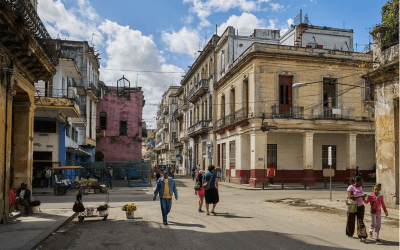The ‘Return’ of the State
Immigration, Transnationalism, and Dual Nationality

Photo by Nuri Valibona. A Honduran woman takes part in a multi-national protest against the INS treatment of illegal immigrants in Miami in May of 1998.
The oath which immigrants are required to swear today on becoming naturalized citizens of the United States, reads, in rather archaic and high-sounding formal language: “I absolutely and entirely renounce and abjure all allegiance and fidelity to any foreign prince, potentate, state or sovereignty, of whom or which I have heretofore been a subject or citizen.” At least in theory new citizens are meant to have one, and only one, loyalty of any kind–to the United States of America. Seemingly at odds with this oath, many immigrants today are taking on, even without any action on their part, dual or multiple loyalties.
Although some of these cases are the result of children born to parents of two different countries, or of children born in a country recognizing birthright citizenship to parents with other nationalities, an increasing number of cases are the result of countries allowing their immigrants abroad to take on additional nationalities without endangering their nationality at birth. In these instances, immigrants’ countries of origin will not recognize the renunciation of loyalties pledged in the U.S. oath of citizenship–nationality in the country of origin is permanent and irrenunciable.
Ten Latin American countries–Brazil, Colombia, Costa Rica, the Dominican Republic, Ecuador, El Salvador, Mexico, Panama, Peru and Uruguay–recognize this form of dual nationality. Immigrants from these countries taking on U.S. citizenship do not lose their home country nationality. An additional number recognize a limited form of dual nationality shared only with treaty signatories–Guatemala, for instance, with other nations in Central America, and a number of countries with Spain. At least ten Caribbean basin nations–among them Antigua, Barbados, Belize, Dominica, Grenada, Jamaica, St. Kitts, St. Lucia, St. Vincent and the Grenadines, and Trinidad and Tobago–also recognize dual nationality, most of them since their independence.
Increasingly, both U.S. and international law have evolved in the direction of increased ambiguity or outright tolerance in favor of dual nationality. For example, while an American citizen cannot take on or claim a formal attachment to another country, a citizen from another country may, upon taking on American citizenship, passively retain citizenship rights in that country if that other country does not recognize, or is indifferent to, the new attachment formed in the United States. Formally, then, the United States discourages dual nationality, while in practice pursuing a ‘don’t ask, don’t tell’ policy. The U.S. Immigration and Naturalization Service doesn’t like dual nationality, or approve of it, but they recognize it.
Commentators on both the left and right have seen the increasing recognition of, and tolerance for, multiple national loyalties as a sign of the decline of the nation-state, and in particular, of American citizenship. The numbers of people migrating, and the ways in which they form and maintain lines of communication, social networks, economic flows, and political interests across borders has led some scholars on the left to assert that we are moving into a post-national world. The argument here is that increasing global internationalization makes the notions of national citizenship seem increasingly archaic and obsolete, and turns to a notion of transnational citizenship instead. Proponents of this perspective stress the emergence of a new formulation for citizenship: a post-national, or transnational, citizenship, with its basis in international human rights regimes. With individual rights disassociated from the state, the importance of national citizenship is fading away. Territorial boundaries are increasingly less relevant as an organizing principle of social interaction, and individuals’ identities are increasingly characterized by fluid, multiple attachments that stretch across frontiers.
The views from the right are not dissimilar in their diagnoses: they too, see the flow of people and political interests as undermining the nation state, and in particular, the United States. But they see these developments as entirely negative. Dual nationality, these critics assert, is like bigamy. Like a bigamous spouse, a person with divided loyalties and commitments is likely to have weaker ties to each. They will shirk their obligations to both objects of loyalty, cheating their fellow citizens in the process. Citizenship is left devoid of substance.
In truth, there is little evidence for either of these sets of observations and/or concerns. If we look at naturalization rates for immigrants in the United States, it is clear that immigrants today are opting to naturalize at rates equal to or higher than that of immigrants in the past. Naturalizations rates in the United States tripled between 1993 and 1996. This was partly due to the introduction by the Immigration and Naturalization Service (INS) of the Green Card Replacement Program in 1992 and of the ‘Citizenship USA’ program in 1995 may also have had an effect on naturalizations. The Green Card Replacement Program required that long-term permanent residents replace their resident cards with new cards; many immigrants chose to naturalize rather than apply for new cards. The Citizenship USA program was designed to encourage naturalization and reduce the backlog in the naturalization process. However, neither of these programs sufficiently explains the increase in naturalization among immigrants in the United States following 1994.
Increased naturalization is largely explained by the 1996 welfare reform legislation, which played a major role in nudging legal permanent residents to naturalize as U.S. citizens. This legislation was designed not only to keep undocumented immigrants from accessing federal public benefit programs, but more drastically, also barring permanent legal residents from participation in Social Security and food stamp programs, and in banning all new resident non-citizens from federal means-tested programs like AFDC (Aid for Dependent Children). Social services, the reasoning went, were not intended for non-citizens, even if these individuals resided permanently in the United States. The 1996 Welfare Reform Act raised the cost of not being a U.S. citizen for legal permanent residents in the United States. With rising costs to not being a citizen, many of these immigrants took the step of acquiring U.S. citizenship.
Taking on U.S. citizenship was arguably facilitated by the recognition of dual nationality by immigrants’ sending countries. In a period from 1991 onwards, a number of major Latin American sending countries all recognized dual nationality. Colombia acknowledged the dual nationality of its citizens abroad in 1991, the Dominican Republic in 1994, Ecuador and Costa Rica in 1995, and Brazil in 1996. Mexico, the Latin American nation with the most immigrants in the United States, recognized dual nationality as of March 1998.
Clearly, from immigrants’ point of view, the state still matters; state policies make a difference in the life-decisions immigrants make. Contrary to predictions on the left, immigrants are not floating in independent social and political spheres unaffected by state decisions. The reaction of immigrants to the passage of the 1996 Welfare Reform Act, as reflected in the dramatic jumps in U.S. naturalization rates, indicate that immigrants are well aware of the costs and benefits of state policies, and adjust their behaviors accordingly. Recognition of dual nationality also enters immigrants’ calculations, but not necessarily in the manner predicted by more conservative commentators. Immigrants from countries recognizing dual nationality are more, not less, likely to take on U.S. citizenship.
Latin American immigrants increased their naturalization as U.S. citizens an average of 105% in the aftermath of the recognition of dual nationality by the sending country. Even taking into account the impact that events like the 1996 Welfare Reform Act had on all naturalization rates, the recognition of dual nationality by Latin American sending countries still gave their immigrants in the United States an edge in naturalizing as U.S. citizens–immigrants from countries recognizing dual nationality were 20% more likely to become U.S. citizens before 1991, and 5% more likely after 1991.
So it’s not the case that the state is somehow fading away from immigrants’ lives. Immigrants are just as likely to naturalize as American citizens, and immigrants who are dual nationals are actually even more likely to naturalize. The changes that have taken place point not to the diminishing significance of citizenship and the state, but rather to their increasing significance. We’ve already noted that in the United States, increasing chances of deportation, loss of benefits, job discrimination, and legal harassment, among other things, make citizenship equally or more valuable for immigrants today as it was twenty years ago. Anyone noting the increase in policing along the U.S. border could hardly argue that there the state has become a less significant presence. But the real difference has been on the part of sending countries.
Mexico is the most significant and interesting example. Over the last twenty years, the Mexican government has become a much larger presence for its immigrants-in the United States. Beginning in the late 1970s, and accelerating rapidly in the 1980s, the Mexican government began cultivating its ties with its nationals abroad (more than 98% of whom are in the United States). The reasons for this policy shift are several, but one point stands out: because of the increasing numbers of immigrants in the United States, money sent back from immigrants abroad are today are almost eight times what they were in 1980. These remittance flows increased from under $1 billion in 1980, to $4 billion in 1994, to over $6 billion in 1999.
As a result, the Mexican government has developed programs encouraging Mexican immigrants to form associations, and prompting the membership of these organizations to remit funds and invest in their local communities of origin. Programs at the federal level include the Paisano program and the Program for Mexican Communities Living Abroad (PCMLA). The Paisano program is designed to improve the treatment that the returning migrants receive at the hands of Mexican officials by reducing corruption and abuse. The PCMLA, established in 1990, provides a wide range of services to Mexican immigrants in the United States through the Mexican consular network and first-generation immigrant organizations sponsored by the consulates, as well as channeling remittances toward local development projects. Hometown associations have served as platforms for matching fund schemes that pool remittance monies with government funds and expertise, and occasionally with private sector contributions, for locally focused economic development projects. Pursuing ties with its immigrants abroad, the Mexican government has extended its presence in the United States. Through its 42 consulates in this country, Mexico has sought to protect the interests of its nationals abroad, to foster their ties to Mexico, and to encourage their active participation in U.S. politics as a friendly lobby for Mexican concerns.
The case of Mexicans in the United States, illustrates that the state (either the sending country’s or the receiving country’s) is in no danger of disappearing as a major actor in immigrants’ lives, setting many of the boundaries and conditions for their participation in various social, economic, and politics arenas. However, the case of Mexicans in the U.S. also underlines the fact that if the state is not losing its sovereignty, its sovereignty is becoming, for the lack of a better word, more porous. Where once state sovereignty might have been thought of as total and complete, each state occupying a unique and mutually exclusive political and territorial space, that is, I would argue, increasingly not the case. Instead we would be better served by seeing the relations between immigrants and states as a system of overlapping sovereignties (which is perhaps an oxymoron), where the politics of states, and the politics of immigrants themselves, exercise greater or lesser degrees of freedom, but which are never absolute. The de-territorialized state is not a new phenomenon. Powerful states have always had commitments and made claims that transcended their borders. What’s new, I think, is not that these states’ power has declined absolutely in the international system, but that it has declined relatively. That is to say, the organizational and administrative resources of other states, like Mexico, has increased to the point where they, too, can extend their influence across political boundaries into what would once have been considered the sovereign domain of other states, even powerful hegemonic states like the United States.
Michael Jones-Correa is Associate Professor of Government at Harvard University. His research and teaching interests include immigration policy, issues of ethnicity and ethnic politics in the United States, urban politics and social movements. He is the author of Between Two Nations: The Political Predicaments of Latinos in New York City (Cornell 1998), as well various articles on, among other things, Latino identity and politics, religion and political participation, the role of gender in shaping immigration politics and Hispanics as a foreign policy lobby.
Related Articles
Forum on U.S. Hispanics in Madrid
The Trans-Atlantic Project, an academic initiative to study the cultural interactions between Europe, the U.S. and Latin America has been invited by Casa de América, Madrid, to present a …
Cuba Study Tour
Waiting at José Marti International Airport for the first Harvard students to arrive for January’s DRCLAS Cuba Study Tour, my companion, a theater critic at Casa de las Américas, commented to me …
The Soulfulness of Black and Brown Folk
And so, by faithful chance, the negro folksong – the rhythmic cry of the slave – stands to-day not simply as the sole American music, but as the most beautiful expression of human experience …




